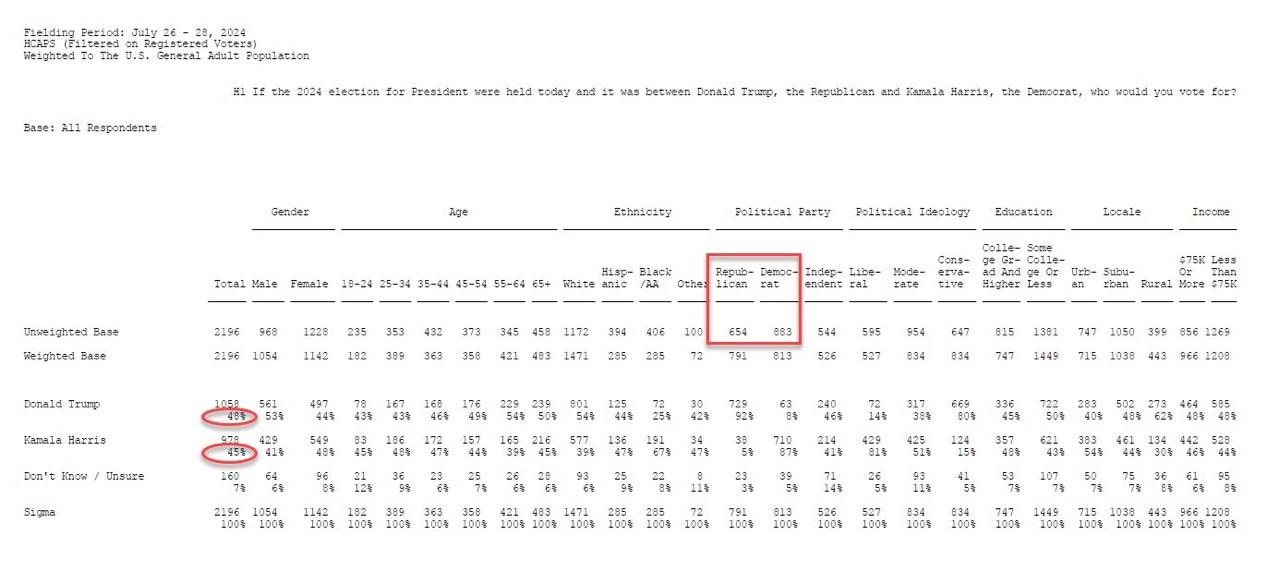The constant, never ending news cycle has given Americans and people around the world the collective memories of goldfish. All it took was one week of puff polling, concert invitations, and the work of paid celebrities on behalf of a candidate who lacks any meaningful accomplishment and failed to reach the Iowa caucus in January 2020 to send people into a panic and bring betting markets back to damn near even.
And the sad part about it is, no amount of countering these Astroturfed narratives seems to have any impact on reversing them. Want to tell the public Wisconsin is a toss-up when Iowa isn’t even being polled anymore, and has no historic precedent in place for Wisconsin to vote for the Democrat nominee with Iowa moving further right into the mid-double digits? Go right ahead. Want to tell me Harris should win Georgia with Trump set to take 25 percent of the black vote, and an even share of the Latino vote? What’s stopping you?
In fact, I got the idea for this article before I saw the flurry of bogus polling by Bloomberg/Morning Consult, which I’ve linked to their paid article so you don’t bother infecting your mind with it. That outfit has jumped in front of the credibility bus at least three times this cycle and is responsible for destabilizing the average of more believable and consistent polling in favor of the regime that is looking to force Harris down our throats (see the hinting of Josh Shapiro as V.P. nominee for further proof, and his role in narrating a steal of Pennsylvania). According to Morning Consult, we can look for Harris to edge Trump in Arizona and Wisconsin, give Trump a run for his money in North Carolina and Georgia while losing Pennsylvania by the largest margin for a Democrat since 1984, and win Michigan by 11 points! That’s a margin worse for Trump than Mitt Romney’s losing margin in 2012, before the white-working class went into GOP overdrive.
I’ve written extensively about the psychological intent of media polling. This year, things are much simpler about it. Trump is a shoe-in to win by all political fundamentals, if the year were 2016 or any year before it. The fake polling this year is designed to give the narrative that Harris could win, so if the election is stolen again, the media will point back to the point at which Biden dropped out (a week after Trump became an historical icon by surviving an attempted assassination), and then reference the polls.
Want a Harris Up in Georgia result? Easy – if your poll should include 15% urban, black women in it – make it 30%. You’ll get Harris up in Georgia. Want to get a positive Harris result in Pennsylvania? Short the white-working class in the central and western portions of the state and inflate the sampling of suburban voters from the Philly metro.
Polls give out from what is put into them, like baking a cake. The poll is only as good as the sampling and turnout forecast are accurate, and even the good ones recognize the margin of error that should account for variables. That means a 46-44% poll is within a 3-point margin of error if the result is 49-41%, or 47-43% the other way. Polling is not exactly an exercise in precision – it is an exercise in establishing trends. Richard Baris, Robert Cahaly, Rasmussen, and a few others do it well. One of those even told me polling is “broken.”
Now, on to the subject matter today. I’m going to show you a Trump +3 poll conducted by Harvard/Harris. The poll has Donald Trump leading Harris 48%-45%, good for a three-point lead, and most certainly good enough to win the Electoral College. Here is a recent Gallup poll on party identification, and when combined with other surveys, it is clear that Democrat and Republican loyalties are damn near 1:1 even, if not slightly favorable to Republicans, and anywhere from a third to half of the electorate calls themselves independent depending on who is doing the questioning.
If I’m doing a national poll and striving for accuracy, I’m sampling partisans at a 1:1 rate, and would probably grab 40% of self-proclaimed independents, or voters who have identified themselves as having voted for presidential nominees of both parties since 2008. So what did Harvard/Harris do?
883 Democrats
654 Republicans
883 divided by 654 gives us 1.35 – or 35 percent more Democrats than Republicans. The poll has Democrats making up over 10 percent more of the entire sample (2,196) than Republicans (40.2% Democrat, 29.8% Republican). And the poll still has Trump winning by three.
Top line aside, here are the key takeaways of this rigged poll:
Keep reading with a 7-day free trial
Subscribe to Captain K's Corner to keep reading this post and get 7 days of free access to the full post archives.




